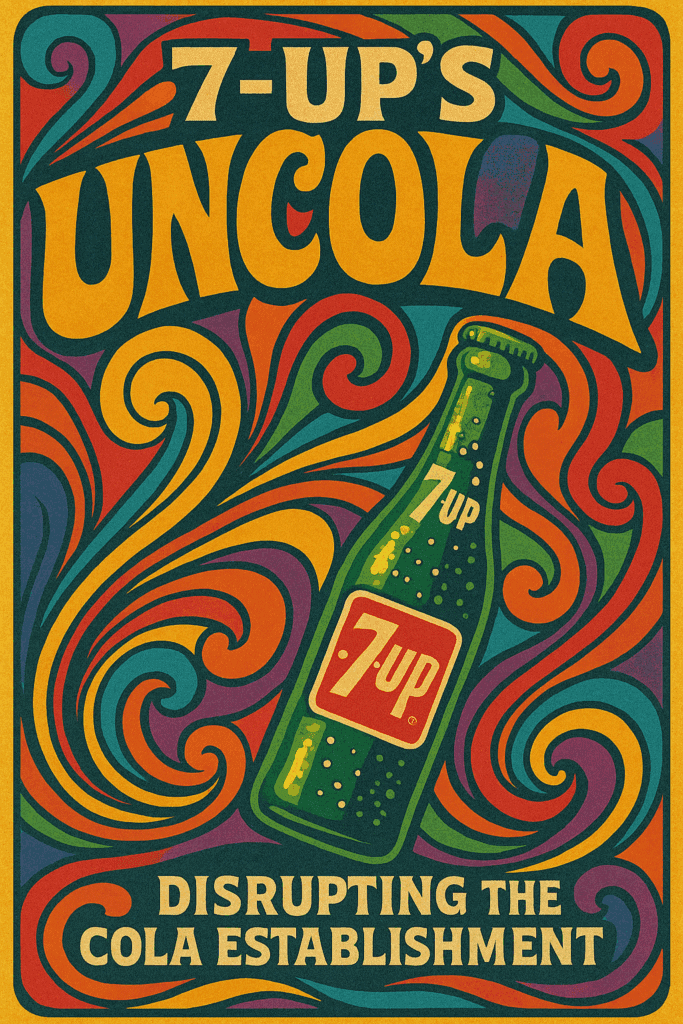Brief Summary

In the late 1960s, 7‑Up broke away from cola conventions with its iconic “Uncola” campaign. Instead of competing directly with Coke or Pepsi, it embraced bold visuals, countercultural vibes, and clever messaging to position itself as the alternative choice — ultimately boosting sales and brand identity.
Company Involved
Marketing Topic
- Brand Positioning
- Advertising
- Cultural Strategy
Public Reaction or Consequences
The campaign struck a chord amid youth rebellion and counterculture movements. Sales reportedly jumped by as much as 30 to 56 percent following the launch. However, by the 1990s, the campaign’s youthful edge aged, prompting a rebrand in 1998.
Why It Matters Today
- Shows how cultural alignment can fuel brand differentiation
- Highlights long-term risks when messaging stops evolving
- Offers lessons in disruptive positioning amid crowded markets
- Relevant for marketers tapping into subculture, TikTok trends, and niche audiences
3 Takeaways
- Flip the narrative: position your product as the antithesis to category leaders
- Tap into zeitgeist: connect authentically with cultural movements
- Evolve intentionally: update branding before your audience moves on
Notable Quotes and Data
- “In one year, sales of 7‑Up went up 56 percent!”
- “The original 7‑Up Uncola campaign stands as one of the most audacious and successful branding efforts.”
- “The entire campaign … catapulted 7‑Up into the position as the third leading soft drink in America.”
Full Case Narrative
By the late 1960s, 7‑Up lagged far behind cola giants Coca‑Cola and Pepsi in both profile and youth appeal. In response, they partnered with ad agency J. Walter Thompson to launch the “Uncola” campaign, positioning the drink as a rebel alternative to mainstream colas.
Visually striking ads featured upside-down cola imagery, psychedelic artwork, and slogans like “See the Light, Feel the Bite” and “Wet Un Wild.” The campaign included a public art contest, giving artists creative ownership and expanding visual diversity.
Sales soared. Estimates suggest a 30 to 56 percent rise within the first year and 7‑Up became the only non-cola in America’s top three soft drinks. As the countercultural moment faded, the youthful edge of the campaign grew dated, leading to its retirement in 1998 as the brand reinvented its message.
Timeline
- 1967: “Uncola” campaign launches with J. Walter Thompson
- 1968–71: Psychedelic billboards, contests, and media spots spread the message
- 1969–70: Sales jump 30 to 56 percent
- 1998: Campaign retired due to aging brand image
What Happened Next?
7‑Up continued experimenting with creative campaigns — introducing “Cool Spot” and “Make 7‑Up Yours” — but none rivaled the cultural punch of “Uncola.” Today the campaign endures as a case study in disruptive, culture-driven branding.
One Sentence Takeaway
Positioning your brand as the daring alternative can work wonders — just remember to evolve with your audience to maintain relevance.
Sources and Citations
Uncola: Seven‑Up, Counterculture and the Making of an American Brand
The Genius Behind the 7‑Up Uncola Campaign
Uncola Marketing: 7UP’s Long Brand Evolution
Positioning Strategy: It’s Not What You Say, It’s How They Think
The Seven‑Up Company and 7‑Up Bottles – The Real Story (PDF)
